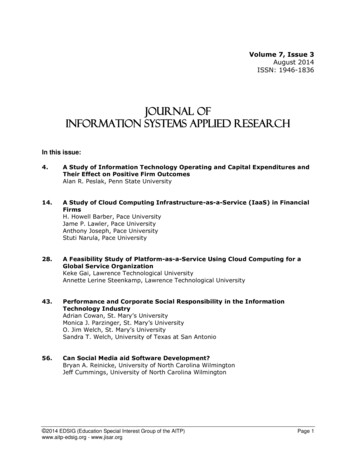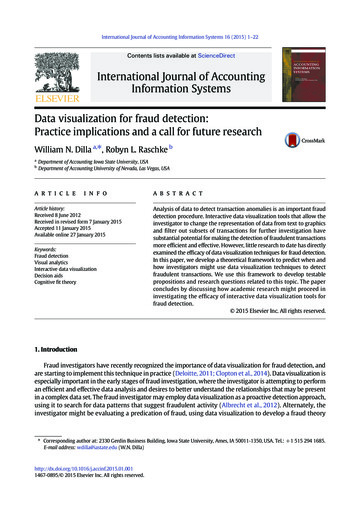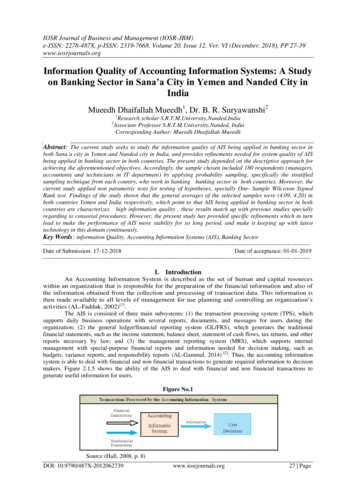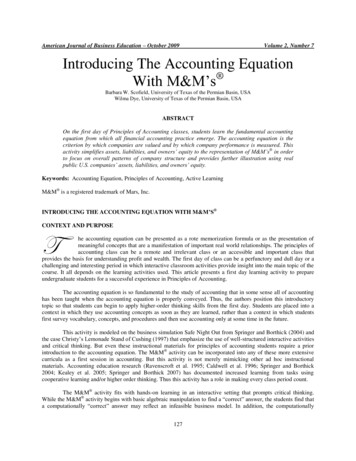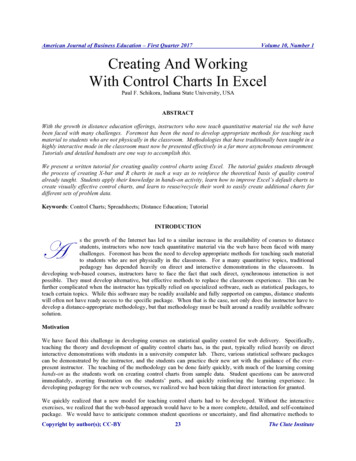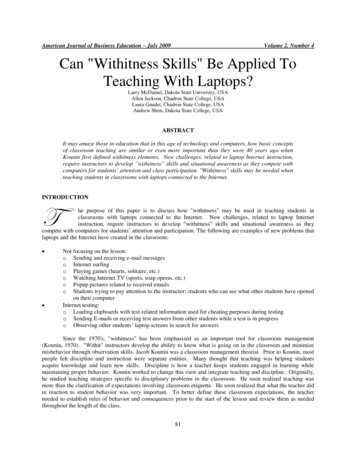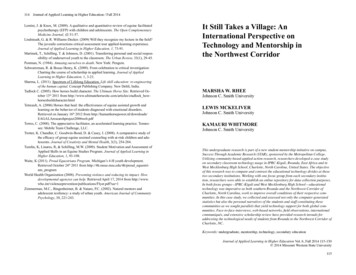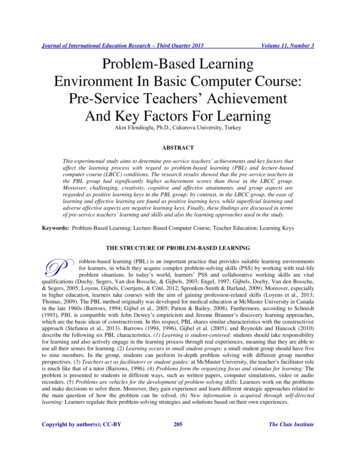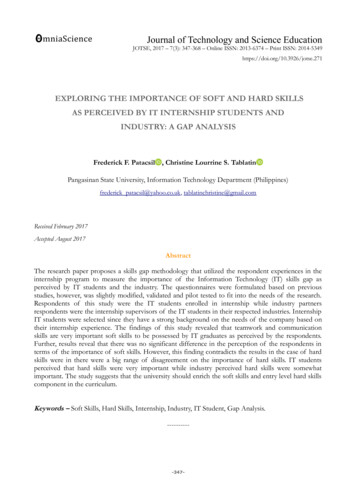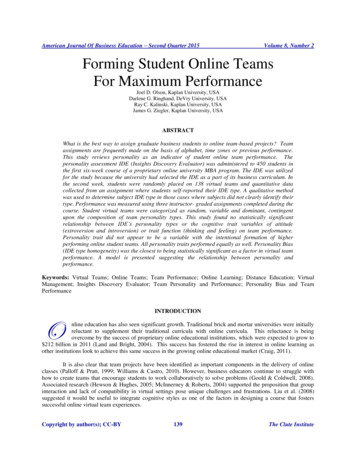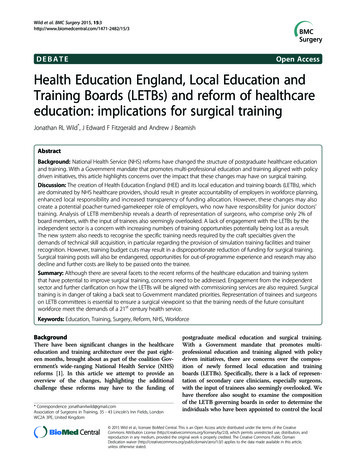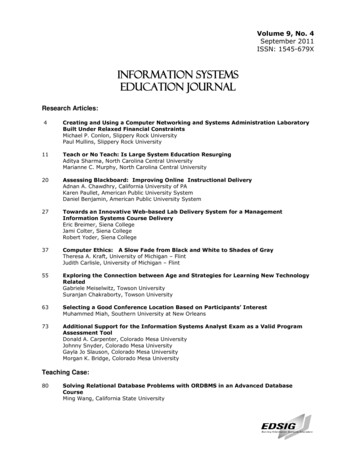
Transcription
Volume 9, No. 4September 2011ISSN: 1545-679XInformation SystemsEducation JournalResearch Articles:4Creating and Using a Computer Networking and Systems Administration LaboratoryBuilt Under Relaxed Financial ConstraintsMichael P. Conlon, Slippery Rock UniversityPaul Mullins, Slippery Rock University11Teach or No Teach: Is Large System Education ResurgingAditya Sharma, North Carolina Central UniversityMarianne C. Murphy, North Carolina Central University20Assessing Blackboard: Improving Online Instructional DeliveryAdnan A. Chawdhry, California University of PAKaren Paullet, American Public University SystemDaniel Benjamin, American Public University System27Towards an Innovative Web-based Lab Delivery System for a ManagementInformation Systems Course DeliveryEric Breimer, Siena CollegeJami Colter, Siena CollegeRobert Yoder, Siena College37Computer Ethics: A Slow Fade from Black and White to Shades of GrayTheresa A. Kraft, University of Michigan – FlintJudith Carlisle, University of Michigan – Flint55Exploring the Connection between Age and Strategies for Learning New TechnologyRelatedGabriele Meiselwitz, Towson UniversitySuranjan Chakraborty, Towson University63Selecting a Good Conference Location Based on Participants’ InterestMuhammed Miah, Southern University at New Orleans73Additional Support for the Information Systems Analyst Exam as a Valid ProgramAssessment ToolDonald A. Carpenter, Colorado Mesa UniversityJohnny Snyder, Colorado Mesa UniversityGayla Jo Slauson, Colorado Mesa UniversityMorgan K. Bridge, Colorado Mesa UniversityTeaching Case:80Solving Relational Database Problems with ORDBMS in an Advanced DatabaseCourseMing Wang, California State University
Information Systems Education Journal (ISEDJ)9 (4)September 2011The Information Systems Education Journal (ISEDJ) is a double-blind peer-reviewedacademic journal published by EDSIG, the Education Special Interest Group of AITP, theAssociation of Information Technology Professionals (Chicago, Illinois). Publishing frequency isquarterly. The first year of publication is 2003.ISEDJ is published online (http://isedjorg) in connection with ISECON, the Information SystemsEducation Conference, which is also double-blind peer reviewed. Our sister publication, theProceedings of ISECON (http://isecon.org) features all papers, panels, workshops, andpresentations from the conference.The journal acceptance review process involves a minimum of three double-blind peer reviews,where both the reviewer is not aware of the identities of the authors and the authors are notaware of the identities of the reviewers. The initial reviews happen before the conference. Atthat point papers are divided into award papers (top 15%), other journal papers (top 30%),unsettled papers, and non-journal papers. The unsettled papers are subjected to a secondround of blind peer review to establish whether they will be accepted to the journal or not. Thosepapers that are deemed of sufficient quality are accepted for publication in the ISEDJ journal.Currently the target acceptance rate for the journal is about 45%.Information Systems Education Journal is pleased to be listed in the 1st Edition of Cabell'sDirectory of Publishing Opportunities in Educational Technology and Library Science, in boththe electronic and printed editions. Questions should be addressed to the editor ateditor@isedj.org or the publisher at publisher@isedj.org.2011 AITP Education Special Interest Group (EDSIG) Board of DirectorsAlan PeslakPenn State UniversityPresident 2011Wendy CeccucciQuinnipiac UniversityVice PresidentTom JanickiUniv of NC WilmingtonPresident 2009-2010Scott HunsingerAppalachian State UniversityMembership DirectorMichael SmithHigh Point UniversitySecretaryBrenda McAleerUniv of Maine AugustaTreasurerMichael BattigSaint Michael’s CollegeDirectorGeorge NezlekGrand Valley State UniversityDirectorLeslie J. Waguespack JrBentley UniversityDirectorMary LindNorth Carolina A&T St UnivDirectorLi-Jen ShannonSam Houston State UnivDirectorS. E. KruckJames Madison UniversityJISE EditorKevin JettonTexas State UniversityFITE LiaisonCopyright 2011 by the Education Special Interest Group (EDSIG) of the Association of Information TechnologyProfessionals (AITP). Permission to make digital or hard copies of all or part of this journal for personal or classroomuse is granted without fee provided that the copies are not made or distributed for profit or commercial use. All copiesmust bear this notice and full citation. Permission from the Editor is required to post to servers, redistribute to lists, orutilize in a for-profit or commercial use. Permission requests should be sent to Wendy Ceccucci, Editor,editor@isedj.org. 2011 EDSIG (Education Special Interest Group of the AITP)www.aitp-edsig.org /www.isedj.orgPage 2
Information Systems Education Journal (ISEDJ)9 (4)September 2011Information SystemsEducation JournalEditorsWendy CeccucciSenior EditorThomas JanickiPublisherDon ColtonEmeritus EditorQuinnipiac UniversityUniv NC WilmingtonBrigham Young UniversityHawaiiNita BrooksAssociate EditorGeorge NezlekAssociate EditorMike SmithAssociate Editor - CasesMiddle TennesseeState UniversityGrand ValleyState UniversityHigh Point UniversityISEDJ Editorial BoardAlan AbrahamsBrenda McAleerLi-Jen ShannonVirginia TechUniversity of Maine at AugustaSam Houston State UniversityMike BattigMonica ParzingerKarthikeyan UmapathySaint Michael’s CollegeSt. Mary’s UniversitySan AntonioUniversity of North FloridaGerald DeHondt IIGrand Valley State UniversityLaurie WernerDoncho PetkovMiami UniversityEastern Connecticut State Univ.Janet HelwigDominican UniversityBruce WhiteSamuel SambasivamQuinnipiac UniversityAzusa Pacific UniversityMark JonesCharles WoratschekLock Haven UniversityMark SegallRobert Morris University.Cynthia MartincicMetropolitan State College ofDenverPeter Y. WuSaint Vincent College 2011 EDSIG (Education Special Interest Group of the AITP)www.aitp-edsig.org /www.isedj.orgRobert Morris UniversityPage 3
Information Systems Education Journal (ISEDJ)9 (4)September 2011Computer Ethics: A Slow Fade from Black andWhite to Shades of GrayTheresa A. Kraftthkraft@umflint.eduJudith Carlislecarlisli@umflint.eduComputer and Information Systems,University of Michigan – FlintFlint, MI 48502, USAAbstractThe expanded use of teaching case based analysis based on current events and news stories relatingto computer ethics improves student engagement, encourages creativity and fosters an active learningenvironment. Professional ethics standards, accreditation standards for computer curriculum, ethicstheories, resources for ethics on the internet, and possible topics for ethical case analyses arepresented. The motivation for teaching Cyber Ethics and a number of success strategies andrecommendations for undergraduate Computer Ethics courses are provided.Keywords: ABET Accreditation Standards, Computing Curricula 2001(CC2001), Professional Code ofEthics, Computer Ethics, Cyber Ethics, Computer Science, Information Technology, ComputerInformation Systems, Pedagogy, Computers and Society.1. INTRODUCTIONThe Accreditation Board for Engineering andTechnology (ABET) has nine common outcomeswhich apply to Computer Science (CS),Computer Information Systems (CIS) andInformationTechnologyPrograms(IT).Computer Ethics is one of these nine outcomesand graduating students must have anunderstanding of professional, ethical, legal,social issues and responsibilities (Homkes &Strikwerda, 2009).In additional to satisfying the accreditationstandard, an undergraduate CS or CIS coursemust engage the students and arch.Students in the Engineering andTechnology fields are problem solvers whotypically look for a single solution (i.e. the code 2011 EDSIG (Education Special Interest Group of the AITP)www.aitp-edsig.org /www.isedj.orgis working or the answer to an equation). Thus,the teaching of Ethics must broaden thestudent’s perspectives and understanding ofcertain real world scenarios, which have noabsolute correct answer but rather multipleviewpoints and opinions. For example a currentevent topic such as the Chinese Censorship ofMicrosoft and Google, has the ChineseGovernment attempting to police and controlinformation provided to the general public,which is contradictory to the freedom of thepress and free speech values of AmericanSociety (Chao, 2010).This paper describes the course format for anUndergraduate CS/CIS course taught at theUniversity of Michigan Flint.The paperpresents the basic goals and objectives of thecourse, the motivation for teaching such acourse, the relevant codes of ethics,ethicPage 37
Information Systems Education Journal (ISEDJ)theories, overview of topics covered, gradingrubrics and additional resources for teachingComputer Ethics.A number of successstrategies and recommendations for teachingundergraduate Computer Ethics are alsoprovided.2. COURSE GOALS AND OBJECTIVESThis course introduces students to the ethicalissues and controversies that comprise the newfield of Cyber-Ethics. The field of Cyber-Ethicsrefers to the broad spectrum of computing andinformation technology ranging from hand helddevices, stand-alone computers, privatelyowned computer networks and the publicinternet. Issues addressed examined the moralresponsibility of computer professionals in thebroadercontextofsocialandethicalapplications of information systems andcomputer technology.In this course, students were discussing ethicalchallenges and ethical controversies usingactual case examples and contentious scenariosto illustrate the various ethical dilemmas andvarious stakeholder viewpoints. In contrast totraditional science and engineering, ethicalissues and cases do not have clear-cutstraightforward solutions. Hence, it is importantto look for strategies, stakeholder interests anddifferent viewpoints of each stakeholder foranalyzing these issues. Students must learn toexamine topics from a variety of perspectivesthat sometimes conflict with each other (Dark,et al., 2008). The course was designed toencouragestudentcreativity,studentengagement, research and writing skills.Motivation for Teaching EthicsThe ABET accreditation requirements state thatthe program of study “enables the student toachieve, by the time of graduation: Anunderstandingofprofessional,ethical, legal, security and social issuesand responsibilities. An ability to analyze the local and globalimpact of computing on individuals,organizations and society” (Homkes &Strikwerda, 2009).The IEEE-CS/ACM Joint Task Force onComputing Curricula recently mandated theinclusion of sixteen core hours of instruction ontopics that are social, ethical, and professionalin the curriculum for undergraduate computerscience students. These topics, each prefacedwith an SP designation, define one “knowledge 2011 EDSIG (Education Special Interest Group of the AITP)www.aitp-edsig.org /www.isedj.org9 (4)September 2011area” or a “CS body of knowledge.” They aredistributed among the following 10 units: SP1: History of computingSP2: Social context of computingSP3: Methods and tools of SP5: Risks and liabilities of safetycritical systemsSP6: Intellectual propertySP7: Privacy and civil libertiesSP8: Computer crimeSP9: Economic issues in computingSP10: Philosophical frameworks ofethics (Tavani, 2002)Of particular interest to ethics instruction per seare the methods and tools of analysis (SP3)which provides students with instruction on howto make and evaluate ethical arguments, andthenidentify and evaluate ethical choices(Tavari,2002).Amongthetopicsrecommended for inclusion in SP 10 areinstructions on philosophical frameworks thatinclude deontological and utilitarian theories.Currently there is a joint committee calledComputing Curricula 2001 ( CC2001) involvingthe Association for Computing Machinery andthe IEEE Computer Society, which is producingcurriculum guidance for the broad area ofcomputing.The purpose of CC2001 is toevaluate future developments in computerengineering in the next ten years (2013) andbeyond. The CC2001 Task Force was asked todevelop a set of curricular guidelines that wouldmatch the latest developments of computingtechnologies and endure through the nextdecade.Principle 10 from the CC2001 TaskForce states:“The computer engineering curriculum mustinclude professional practice as an integralcomponent of the undergraduate curriculum.These practices encompass a wide range ofactivities, including management, ethics andvalues, written and oral communication,working as part of a team, and remainingcurrent in a rapidly changing discipline”(McGettrick, et al., 2003, p. 9).In addition to the requirements of the ABETaccreditation standards and those of the IEEECS/ACM,an understanding of ethics isparticularly important to Computer and ITstudents due to the ubiquitous nature ofcomputers,informationtechnology,websystems and internet applications in our dailyPage 38
Information Systems Education Journal (ISEDJ)9 (4)September 2011lives. Computer applications and informationsystems are used by people to drive cars,control life preserving and life taking devices,and affect many daily functions from ter and Information Systems are acritical component of our society and citizensand customers do not and cannot be expectedto understand the systems on which theydepend for vital life functions (Johnson, 2007). Promote management’s understandingof information processing, Act with honesty and respect, Participate to the best of their abilitiesin the distribution of IT knowledge, Protect confidential knowledge, Uphold the ethical and moral principlesof educational institutions,Computer professionals must act in a sociallyresponsible and ethical manner to be worthy ofthe public trust. The special talent andknowledgerequiredfordevelopingandmanaging these IT systems leads to a socialresponsibility to u
thkraft@umflint.edu Judith Carlisle carlisli@umflint.edu Computer and Information Systems, University of Michigan – Flint Flint, MI 48502, USA Abstract The expanded use of teaching case based analysis based on current events and news stories relating
